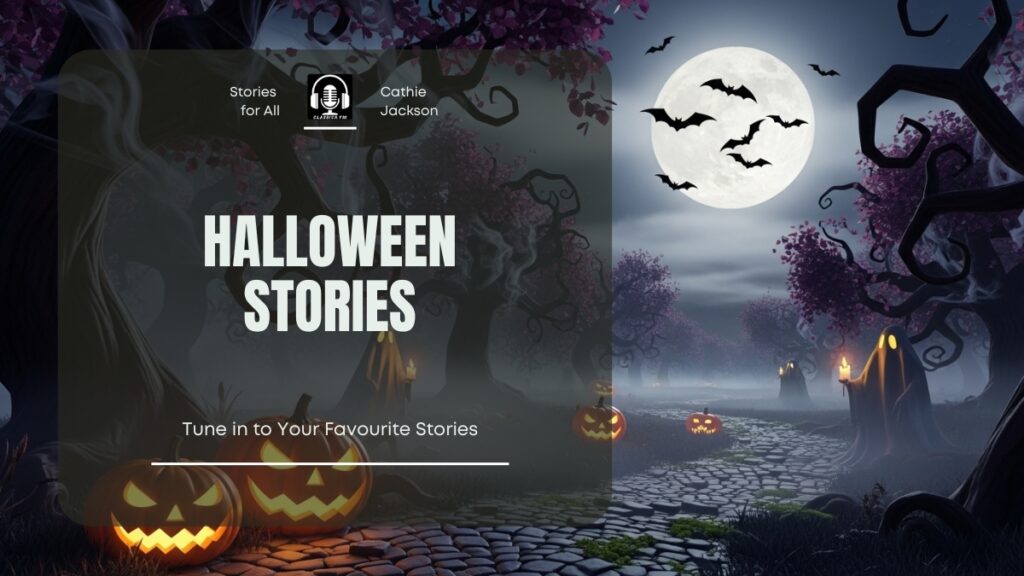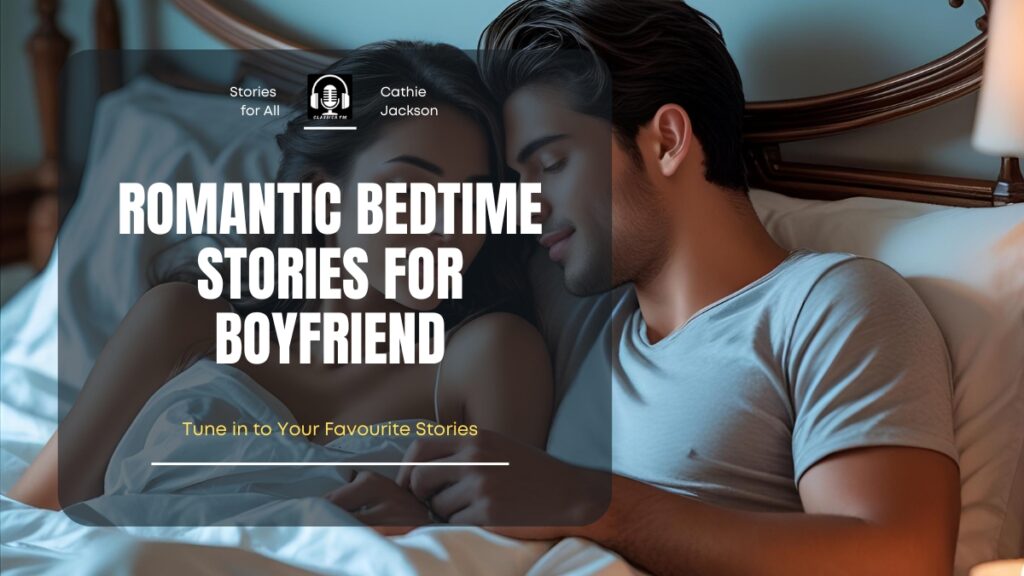Want Halloween stories that actually land, whether you are five or seventy-five, a neighbor handing out candy, a college kid on a late-night walk, or someone who just likes a good shiver over tea? Perfect.
This guide is for everyone. It keeps the fun and the chill without turning into a horror manual. It is warm, a bit messy on purpose, full of voice, and built to be used. Use it at a party, at a family gathering, on a lantern walk, or when you are alone and curious.
This is evergreen. It is about mood, technique, and human connection. Themes like fear, belonging, courage, kindness, and the little mysteries that flicker at the edge of the lamp are timeless. Ready? Let us light the lantern.
Why Halloween stories still matter for everyone
Stories help us practice feelings. Fear included. When we sit with a spooky story we are practicing curiosity and boundaries, empathy and humor, all wrapped together. Why tell them at Halloween? Because culturally the season hands us permission to explore the uncanny, to laugh at what makes us jump, and to gather as a community around small rituals. It is the part of the year where a crackle of leaf underfoot and a flicker of orange light can mean something shared.
Also, stories teach us how to face things we do not fully understand. They let us say, “Okay, that was spooky,” and then they let us laugh or breathe or hug someone and move on. That is useful at any age.
Who is this for
Short answer: you.
- Adults who want to tell a tale that is not childish.
- Teens who want mood and nuance.
- Community leaders running neighborhood events.
- Writers polishing a short form ghost story.
- Anyone who wants an inclusive, ethical, thoughtful approach to spooky storytelling.
No heavy theology, no gore. Just mood, meaning, and things that make people lean in.
Choosing the right tone for your group
Not every spooky story suits every crowd. Tone matters more than content. Here is a quick sense-check to help you choose.
Low chill
Good for mixed-age gatherings, workplaces, casual parties. Think: gentle mystery, warm humor, community. Example: a lost lantern finds a home.
Medium chill
Older teens, friends, evening gatherings. More atmosphere, a hint of ambiguity, quiet unease rather than shocks. Example: an abandoned house that keeps giving back small objects.
High chill
Late night, adults-only, comfortable with ambiguous darkness. Psychological edges, uncanny details, not gratuitous gore. Example: an urban legend that takes a twist about memory and identity.
Ask the group. Consent matters. Before you begin, say: “Want something cozy or something that will give you goosebumps?” Let people opt out. Nobody needs to be left shivering.
Voice and style that work for grown-up ears
Variety. Authentic voice. A little raggedness. Use short lines and long ones. Fragments. An aside now and then, like a storyteller nudging the listener. Rhetorical questions. Slang and regional phrases when they fit. Imperfections are human. They build trust.
Try this mix:
- Short punch: “A light moved behind the window.”
- Slow build: “It was the sort of light that had the patience to wait until midnight, the sort that softened the edges of the house and made the porch look like a memory.”
- Fragment: “Leaves. Wind. A shoe on the step.”
- Aside: “You know how it is, right? You think it is the cat, but it is not the cat.”
Use local color. If you are in a city, drop in the subway hum. If you are in a village, mention the curfew bell. Little details make stories feel lived in without claiming that you personally lived them.
Halloween Stories
Below are story ideas with tone notes, ways to tell them, and quick twists you can use. These are templates. Make them yours.
The Lantern That Wanted to Belong
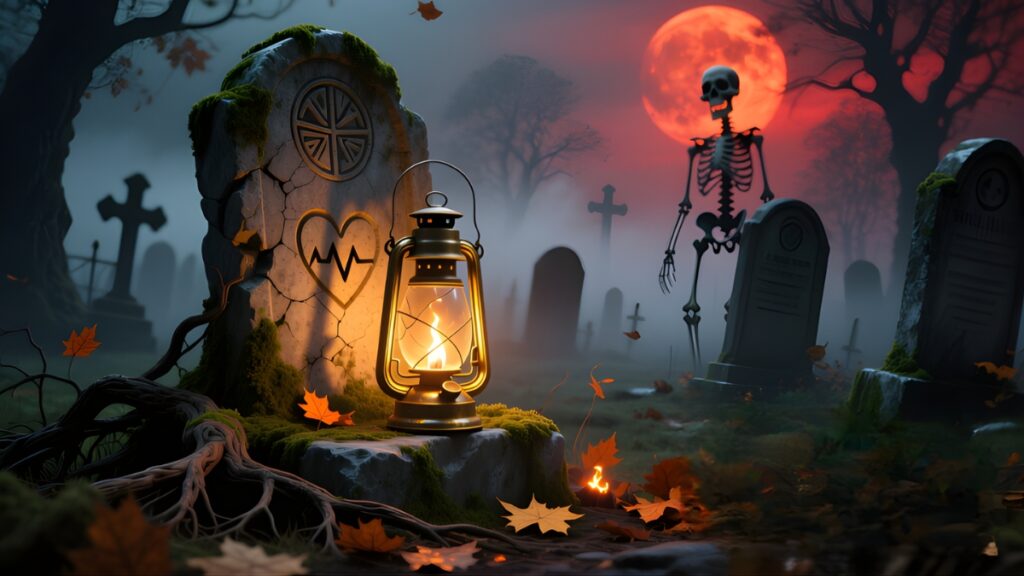
It appeared on the first porch one chilly October evening.
Not abruptly. Not with a clatter. Just a faint glow hovering at the edge of the steps.
Martha, who lived in Apartment 2B, noticed it first. She was watering her window plants when she saw the little light.
It wasn’t like the electric bulbs she had strung for decoration. It flickered, unevenly, almost shyly.
She bent closer. “Hello?” she whispered.
Nothing. But the lantern tilted slightly, as if acknowledging her voice.
The next morning, she found a single leaf tucked beneath it. A small gesture. Martha didn’t know why she kept it, but she did.
By the third evening, the lantern had moved two houses down the street.
At first, the neighbors assumed someone was playing a trick. Kids with Halloween candy in hand, maybe. But no one claimed it.
The light was soft. Almost warm. It did not leap or sway with the wind. It simply settled.
A small bowl of sugar water appeared beside it. Just a spoonful.
No one spoke about it. No one needed to.
Word began to spread. Quietly, almost imperceptibly.
“This has been happening for three nights,” Mrs. Delgado said to no one in particular at the corner store. “A little lantern. Moves from porch to porch.”
People leaned in, curious. Some laughed. Others shivered slightly, but pleasantly. The air seemed charged, a quiet anticipation without fear.
The lantern seemed to listen.
It lingered longer where there was memory. A porch with faded letters. A mailbox with photos tucked behind the glass. A garden where someone had once buried a beloved pet.
On one evening, it paused in front of an empty swing. No one had lived there for years. But the neighbors knew the child who once played there. The lantern’s glow reflected the memory, not the absence.
Everyone wanted to leave an offering.
Some left sugar water. Some a carved pumpkin. Others, a simple note: “We remember you.”
It became a nightly ritual without a name. People didn’t talk openly. They just left small gifts.
Even the children began to notice.
“Mom, it moved to Mr. Thomason’s porch tonight!”
“Yes, sweetie. Let’s leave him a little note,” the mother replied, eyes reflecting the soft light.
The lantern accepted the offerings without fanfare. It did not bow or move faster. It simply glowed, brighter than before.
One evening, Mr. Thomason himself stepped onto the porch.
He was an older man, long retired, known for his quiet ways.
“I remember my friend,” he said aloud.
The lantern shimmered. For the first time, it hovered in place for more than an hour.
Neighbors peeked from their windows. They saw a subtle dance of light, not harsh, not electric, just a gentle sway.
It was as if the lantern had found a home.
Soon, the neighborhood fell into rhythm.
Each evening, someone left a token. Sometimes multiple people. Sometimes none. It did not matter.
The lantern moved deliberately, almost thoughtfully. It would linger longer where laughter had been, where someone had felt sorrow, where someone had spoken a name aloud after years of silence.
It was a quiet witness.
Some nights, people left letters.
Not long letters. A line. A sentence.
“I miss you.”
“Your kindness is remembered.”
“Thank you for being my friend.”
The lantern glowed brighter for these. The neighbors claimed it responded, but maybe it was just the shared warmth.
A week passed. The lantern had made its rounds. Then, a curious thing happened.
It paused in front of a house with peeling paint and broken shutters. No one lived there now. But a plaque in the window read: “In memory of Anna T.”
Martha and Mr. Thomason watched quietly from a distance.
The lantern hovered longer than ever. Its light spilled onto the cracked porch and the overgrown garden.
Then, as though satisfied, it floated gently above the roof and disappeared.
The next morning, there was a subtle change.
Neighbors found small gifts on their porches: pumpkins carved with gentle faces, a leaf pressed inside a glass jar, a note left anonymously.
The lantern was gone.
But it had left something behind.
A sense of connection.
A sense that memory mattered.
And a quiet reminder that even in absence, small gestures could illuminate lives.
Some claimed they saw the lantern again in later years.
Sometimes it hovered over celebrations. Sometimes over sorrow.
It became a tradition, a story told quietly in the neighborhood: “The lantern that wanted to belong.”
People did not argue about its origin. They did not ask questions. They simply remembered to leave a light on, a token, a note, a thought.
Even the children, now grown, remembered.
There were nights when the lantern vanished entirely.
Weeks, months, even years might pass. But the rituals remained. People found each other through small gestures. Notes tucked into mailboxes. Leaves left on old porches. A bowl of sugar water on a windowsill.
And when someone mentioned it in conversation, others would nod knowingly.
“Yes. The lantern moves where memory lives.”
The story could end here.
Or it could end differently.
Some say the lantern returns only when the neighborhood heals a long-ignored rift.
Others say it simply moves on. Always seeking the next porch, the next memory, the next gentle heart that needs to remember.
Either way, it leaves the same lesson: small acts of remembering matter. Light can belong. And belonging can be shared.
The Apartment That Gave Back Things

Nobody ever remembered when the story started. Some said it was the winter of 1998, others said it was long before that, back when the city still smelled of rain-soaked newsprint and steam rising from the subway grates.
But everyone agreed on one thing: Apartment 3B, in that rent-stabilized brick building on Madison and 43rd, had a way of returning what was lost.
At midnight.
Every night.
It didn’t happen loudly. There were no flashing lights or rattling walls. Just soft thuds in the hallway, sometimes a faint clink, as if something metal rolled to rest against the baseboard.
Mrs. Alvarez was the first to talk about it. She was old, with silver hair always in curlers, and her apartment smelled of warm cinnamon and tiger balm. She said she’d been half asleep when she heard a knock at her door. When she opened it, she found a key on the floor.
Not just any key. Her husband’s old Ford key. The one he’d lost in 1982.
Her husband had been gone twenty years by then.
She cried so hard that night the neighbors thought someone had died.
Word spread fast, as these things do.
At first, people thought it was a prank. Teenagers sneaking into the hallways, placing random objects to freak out the old tenants. But when Mr. Lee in 4A found a small silver cross he hadn’t seen since his mother’s funeral, people began to whisper something else.
The building was returning things.
Lost things. Forgotten things.
Things that still had a little bit of longing left in them.
By February, the hallway was busy again. Tenants who hadn’t spoken to one another in years were sharing tea and theories. “Maybe it’s the janitor,” said someone. “Maybe it’s the old wiring, the magnetic pull.” Someone else laughed, “Or maybe the building just has a good memory.”
They were joking, but half-serious.
Because when you live in a place long enough, walls remember. The smell of burnt toast, the rhythm of footsteps, the sound of heartbreak muffled by thin plaster.
Walls know.
Then came the story of the photograph.
A new tenant, Julia, moved into 5C. She was quiet, young, with tired eyes from working double shifts at the hospital. One night, she found a photo lying on her doormat — two kids in Halloween costumes, holding up paper pumpkins.
She picked it up and smiled.
It was her. At seven.
The photo had been lost years ago in a flood that ruined her childhood home. She turned it over, heart pounding, and saw her father’s handwriting. “For my brave girl.”
She hadn’t heard from him in over a decade.
That night, she sat by the radiator and cried quietly into her sleeve.
After that, people stopped asking how it happened and started asking why.
Was the building trying to tell them something? Fix something?
Mr. and Mrs. Kumar in 2D started leaving small notes by their door before bed. Things like “We miss you, Rajesh” or “Please let us find peace.” Their son had moved away years ago, after a bitter fight.
One morning, a letter slid under their door. It wasn’t new. The envelope was yellowed, sealed with brittle tape.
It was from Rajesh.
Postmarked 2009.
A letter that had never arrived.
Not everything that came back was comforting.
Sometimes the items confused people.
A single earring. A bus ticket to a city no one had visited. A keychain shaped like a locket, with no picture inside.
Some things made people uneasy. A folded piece of paper with the words “I’m sorry” scrawled in fading ink. A child’s toy, cracked and burnt at one corner.
The building didn’t discriminate. It just gave things back.
A few adventurous tenants started leaving offerings, just to see what would happen.
One man placed a broken wristwatch on the hallway shelf. It was gone the next day. A week later, it returned, ticking softly, set to the correct time.
A woman left her engagement ring — not lost, but unwanted. It never came back.
Another tenant left a question scribbled on paper: “What do you want from us?”
That note returned too. But the handwriting was different.
It said, “To be remembered.”
Now, I should probably admit something.
I lived there once.
In Apartment 3B, actually.
Yeah, that 3B.
I didn’t believe the stories either, not at first. I thought it was city gossip, another weird New York thing people romanticized to distract themselves from rent hikes and leaking faucets. But then, one night in early November, something happened.
I was cleaning the kitchen when I heard the knock. Soft, almost polite. I opened the door.
And there it was.
My old leather notebook.
I had lost it in college — ten years ago, in another city.
Inside were sketches, bad poems, and one letter I had written to my best friend before he died in a car accident.
I had never mailed it.
And somehow, it was back in my hands.
That night, I couldn’t sleep.
I walked the hallways, half expecting to see someone, half terrified I would. The air was cold and still, the way it gets when the city holds its breath. The doors all looked the same — chipped paint, brass numbers dulled by decades.
Then I saw it.
A shadow.
Not moving, exactly. Just there, against the wall, faintly shaped like a person standing still.
I didn’t run. I just whispered, “Who are you?”
And something in the air shifted, like static before rain.
The lights flickered, and the shadow was gone.
But I swear I heard a voice.
A whisper, so soft I could barely catch it.
“We keep what you forget.”
After that, I started noticing things.
Scratches near the baseboards, like initials carved in haste. Bits of old wallpaper peeking through the fresh paint — floral patterns from the 1940s. A faint smell of smoke on the third floor where, rumor had it, a fire once broke out.
The building was layered with memories.
Each repair was like a patch over someone’s story.
And maybe, somehow, the building wanted to balance the scales.
The next few months changed everything.
People began leaving out small boxes, envelopes, sometimes just open palms. The building kept returning things, but now, something else was happening.
Old arguments were mending.
Estranged families met in the hallways again.
Neighbors started sharing dinners, laughing softly about “their haunted little building.”
It felt like the walls were sighing in relief.
But one night, something new appeared.
A door.
Not one that had ever been there before. Between 3A and 3B, a slim, dark door with no knob. Just a small brass plaque that said Return Office.
People gathered around it, hesitant but curious. They knocked. Nothing.
Someone left an envelope in front of it. A week later, that same envelope reappeared — taped to their apartment door with a photo inside.
The photo showed the hallway. But the mysterious door was gone.
Eventually, life went back to a strange kind of normal.
The midnight thuds became routine. The returned items found homes again. Some people moved out, unable to handle the eeriness. Others stayed, claiming the building had healed them in quiet ways.
As for me, I left too, years later. But sometimes, when I lose something — a letter, a thought, a friend — I still think of that place.
And I wonder if the building is still there, patiently returning what the world forgets.
Epilogue: A whisper of what remains
They say that if you walk by Madison and 43rd at midnight, you might see a faint glow in one of the top windows.
Not electric light. Softer. Warmer.
Like the color of memory.
Some swear they’ve found small things near the stoop — an old key, a broken bracelet, a folded note with a name they almost remember.
Most people just shrug and keep walking.
But if you stop and look up long enough, you might hear it too.
A soft hum in the pipes. A rustle in the vents.
The sound of a building remembering you back.
The Neighbor Who Hummed in the Walls
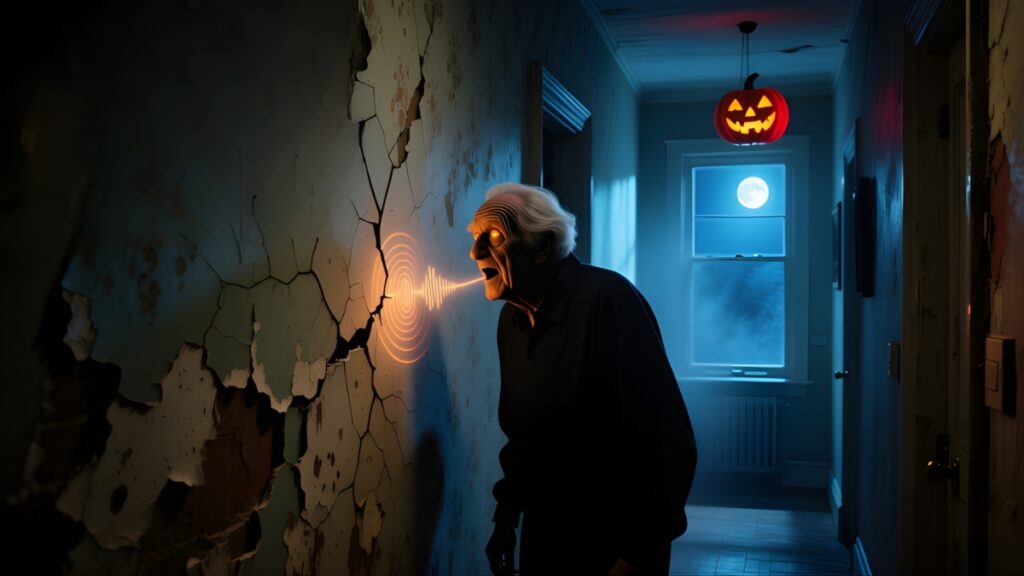
It started as a sound.
Soft. Almost accidental.
A faint hum. Low and irregular. Not a tune you could name. More like the memory of a tune. A half-forgotten lullaby.
I first noticed it on a Tuesday.
I was making tea, the kettle singing its own kind of song, when the hum joined in. A thin, wavering note from somewhere inside the wall.
At first, I thought it was a neighbor practicing, maybe an old man singing to himself. But the timing was too precise. Too… deliberate.
By Thursday, it had become something I noticed before noticing it.
I was in my living room, reading. My cat, usually aloof, perked up and twitched its ears toward the wall. The hum shifted slightly, almost as if responding to her attention.
I frowned.
No one had moved in yet. No one new in the apartment.
The hum wasn’t annoying at first. Just… strange. A sound that settled behind your ribs like a memory you couldn’t place.
I asked around.
“Do you hear anything?” I whispered to Mrs. Chen, my neighbor across the hall.
She shook her head. “I live with my music, but I haven’t heard a thing. Maybe you’re imagining it.”
I almost believed her. Almost.
By Friday, I realized I couldn’t ignore it.
The hum had a pattern. Rising and falling. Sometimes long notes, sometimes staccato stabs that reminded me of a typewriter clacking across pages.
I started sketching it. Little bars, dashes, dots. Music? Morse? I didn’t know.
Every evening, the hum returned at the same hour. 10:17 pm. Sharp in its punctuality.
Curiosity grew into a kind of nervous obsession.
I tapped the wall. Lightly. Not hard enough to annoy anyone, but enough to leave a mark.
The hum responded.
A pause. Then a change in rhythm. Almost like it was listening.
I felt a thrill, a chill, and a worry all at once.
The building itself seemed to breathe with the hum.
The plaster cracks lined up differently in its rhythm. Shadows shifted on the walls as though keeping time.
Neighbors began noticing.
Mr. Ahmed in 2C, usually quiet, knocked on my door. “I hear it too,” he admitted. His voice was careful. “Not every night. But when I do, it’s… odd. Kind of sad, but persistent.”
The hum had become communal.
It was on Saturday night when I first tried to map it.
I leaned against the wall, notebook in hand, and traced each note. Short, long, short, pause. A pattern emerged, like braille or a secret language.
Could it be musical? Could it be a message?
I shared the findings with two other neighbors, hesitant but desperate for answers.
They were intrigued.
By Sunday, the hum seemed aware of our attention.
It changed pitch when we walked down the hallway. Softer when we whispered, louder when we laughed.
It was intimate, almost invasive. Almost comforting.
Some nights, we sat quietly on the stairs, not talking, just listening.
It became a ritual.
Then came the strange bit.
The hum wasn’t random. It followed us outside.
If we lingered too long in the hallway, the faint echo trailed us onto the stoop. Across the street. Sometimes it was faint enough that only one of us noticed. Other times, it seemed loud enough to fill a car parked at the curb.
We joked it was following us like a ghost.
But none of us were laughing fully.
Mrs. Riley, who lived three floors above, decided to investigate.
She knocked on all the walls, every apartment in her line of sight. No one answered.
But the hum responded.
A long note, held steady for thirty seconds. Then gone.
She told us she felt watched. But not threatened. Watched like a diary being read softly, gently, without judgment.
Speculation ran wild.
Was it a protest?
An eccentric old neighbor against gentrification? A musician so old-fashioned that he preferred invisible instruments? A lonely person asking to be seen?
We had theories. None of them quite fit.
Even our landlord, Mr. Crenshaw, laughed.
“Walls hum? That’s new,” he said. But he didn’t interfere.
People began leaving small tokens near the walls.
A cup of coffee. A folded note with “thank you for the song.” A tiny paper crane.
The hum shifted again. Softer when we left the items. Louder when we returned.
It was listening. We were learning to listen too.
The hum started weaving through our lives.
I would hear it in the morning sometimes, faintly, even when the building was empty.
Neighbors began greeting it. “Good evening,” we whispered at the wall, sometimes jokingly, sometimes sincerely.
Even children noticed. They stopped poking holes in the plaster and started tapping lightly, waiting for the response.
The hum became a shared secret.
One night, curiosity got the better of me.
I took a ladder to the maintenance hatch in the attic.
The hum was loud there. Vibrating. Almost physical.
I pressed my ear to the cold metal ceiling.
It didn’t come from anywhere in the attic. It was everywhere.
And yet, it was somewhere.
I started taking notes obsessively.
Patterns. Rhythms. Shifts in pitch. Repeats at odd intervals.
It formed a kind of map. Not of apartments, exactly, but of lives. Of footsteps, conversations, small secrets.
The hum remembered things we had forgotten.
By winter, the hum had become something like a guide.
Neighbors followed it to find missing keys. Lost mittens. Notes someone had thrown away long ago.
A library card. A tiny photograph. A wallet.
The hum returned objects the way a friend might. Gently, without commentary, with perfect timing.
Some nights, we argued about it.
“Maybe we shouldn’t encourage it,” someone said. “What if it’s dangerous?”
Another neighbor laughed. “Dangerous? It’s just humming. Nothing’s coming out of the walls except memories.”
We could feel its presence most strongly when we were honest.
Then came the winter festival.
The building decided to reveal itself, or at least, we think it did.
Lights flickered in sequence across the walls. The hum harmonized with them.
We could almost see a figure, not human exactly, but shaped by the echoes of everyone who had lived here.
And it seemed to nod.
After that, neighbors started leaving small gestures deliberately.
A cup of tea. A knitted scarf. A candle.
The hum softened in response. Almost a sigh of relief.
It seemed to approve of human kindness. Of attention.
Years passed.
New tenants came. Old tenants left.
But the hum remained.
It became a story that defined the building. A legend, yes, but one that was lived every night.
Tenants new and old learned to whisper, to pause, to listen.
Even people passing by would sometimes stop and press an ear to the wall.
And they would hear it: a faint, irregular tune. Waiting for attention. Waiting to be understood.
Some nights, the hum sounded almost like laughter.
Other nights, it wept softly.
Some nights, it was a conversation we couldn’t understand.
But always, it reminded us that we were part of something bigger.
That even in isolation, walls can hold memory. And that music, even accidental, can connect lives.
Eventually, I realized something.
The hum was not one neighbor. Not even one person.
It was the sum of everyone who had lived there. Their joy, their sorrow, their secrets.
The walls didn’t just hum—they remembered.
And they invited us in, gently, quietly, to remember with them.
The building became a quiet legend.
People moved in for the stories. They stayed for the hum.
Even now, long after I’ve moved out, I find myself hearing it in my dreams.
Faint. Irregular. Reminding me that even a city full of strangers can hum together, if we just listen.
The Moonlit Parade of Masks

It started like every urban legend does —
with a whisper in the hallway.
No one knew who said it first. Maybe the doorman, maybe the girl from 4B who always had stories about haunted elevators.
But the idea spread fast.
There was someone in the building who could take away a memory.
Just one.
In exchange for a secret wish.
At first, it sounded like gossip. The kind of late-night rumor you tell with too much wine, laughing to prove you’re not afraid.
But then came the stories.
Tiny, verifiable things.
A woman who forgot her fear of water — and learned to swim again.
A man who woke up one morning and realized he could no longer recall the face of the coworker he hated.
A boy who wished his nightmares gone, and slept peacefully for the first time in years.
No one saw the trades happen. They just… did.
People began calling the figure the neighbor.
Not “the thief,” not “the witch.” Just “the neighbor.”
Because it sounded ordinary enough to be true.
Some said the neighbor lived in the basement, behind a locked storage room.
Others said they lived on the roof, in one of those forgotten sheds filled with rusted pipes.
Every version agreed on one thing — you never saw the neighbor twice.
It was simple, they said.
You left a note under the stairwell.
Wrote down what you wanted.
Folded it three times.
Then, sometime in the next few nights, you’d wake to find a single black thread tied around your wrist.
And a memory would be gone.
Nobody talked about how it felt.
You’d think forgetting would be relief, like unclenching a fist you’d held too long.
But most people described it differently.
Like a missing tooth.
Your tongue keeps searching for it.
And when you don’t find it, something aches anyway.
I didn’t believe the story. Not really.
Until the night my neighbor — the real one, Mrs. Davenport — knocked on my door with tears in her eyes.
She said, “I don’t remember why I came here.”
Her voice was flat, almost peaceful.
Then she smiled. “But I know I wanted to be kind.”
She handed me a bouquet of slightly wilted tulips.
And I believed her.
That night, curiosity took over.
I wrote a note. Just to see what would happen.
It said, I wish I could stop missing her.
I folded it three times, just like the rumor said.
Left it under the stairwell.
Went back upstairs, heart pounding like I’d done something wrong.
I woke up at 3:14 a.m. to the smell of smoke.
Not fire. Not danger.
Just the faint scent of something burnt — like paper, or incense, or memory.
And there it was.
A thin black thread tied around my wrist.
At first, nothing felt different.
I brushed my teeth, made coffee, scrolled aimlessly through messages.
Then I noticed something strange.
There was a photo on my fridge — me and her.
We looked happy.
But I couldn’t remember the day.
The park, the weather, the laugh that had made me fall in love.
Gone.
The picture was evidence of someone else’s life.
I should’ve been terrified.
Instead, I felt light.
Like grief had been unplugged.
And that scared me more than anything.
Because if pain is gone, what does that make you?
Free? Or hollow?
The building began to change after that.
People smiled more. The air felt less tense.
You could sense a kind of collective forgetting.
Fights between couples disappeared overnight.
Old grudges softened.
Neighbors who hadn’t spoken in years started saying hello.
The hallways grew quieter — but not peaceful.
It was the quiet of a place holding its breath.
Then came the price.
Mrs. Davenport’s daughter visited one weekend.
She knocked on my door again, holding a photograph.
“Do you know this woman?” she asked.
It was her mother. Smiling.
I nodded.
“She doesn’t remember me,” the daughter said.
And I finally understood.
The wish had worked too well.
That week, new notes appeared under the stairwell.
I wish I could forget my mistakes.
I wish I could sleep.
I wish I could start over.
The paper was thin, creased, fragile.
I never saw who left them.
But every morning, they were gone.
And every morning, a new hush settled in the halls.
The elevator stopped making its familiar groan.
The pipes no longer rattled.
Even the city noise outside seemed muffled, like someone had pressed a soft cloth over our lives.
You could almost hear the neighbor breathing in the walls.
One night, someone tried to test it.
A young man from 2D, a skeptic, left a note that said: Take nothing. I want nothing. Prove you’re real.
The next day, he moved out without saying a word.
His apartment stayed empty.
Sometimes, when I walked past his door, I’d hear faint laughter.
Not cruel laughter. Just… remembering.
The building was full of absences now.
People forgot their favorite meals, their anniversaries, the faces of lost friends.
They didn’t mind.
It was easier not to mind.
That was the trick of it.
Comfort replaces curiosity.
Silence replaces grief.
And before you know it, you’ve forgotten what mattered at all.
I thought I could live with it.
Until one morning, I couldn’t recall my own handwriting.
I found notes in my desk drawer — small scraps written in my script, but they felt foreign.
One said: If you forget her, you forget yourself.
Another: Don’t make another wish.
And the last: You already did.
Panic clawed at my throat.
Had I written them? When?
The black thread around my wrist had frayed.
I pulled it off — or tried to.
It dissolved into ash.
And in that moment, I remembered everything.
Every tear, every ache, every reason I had wanted to forget.
It hit me like thunder after years of silence.
And yet, beneath the pain, something else pulsed.
Gratitude.
Because memory, even the hard kind, was proof of being alive.
I left the building that night.
Couldn’t bear the stillness.
Outside, the air was sharp and honest.
The city felt real again — loud, messy, full of smells and mistakes.
For the first time in months, I felt present.
And somewhere behind me, in the faint hum of a lightbulb or the echo of a door closing, I thought I heard it —
the neighbor’s voice.
Low. Almost kind.
“Keep what’s yours.”
But the legend didn’t end there.
Every few years, new tenants moved in.
And the story began again.
They said it always started with a note found in the basement.
Yellowed. Torn.
It read: One memory for one wish.
Some ignored it. Some laughed.
And some — the desperate ones, the lonely ones — folded a piece of paper three times and waited.
Those are the ones who wake up lighter.
They walk differently, eyes softer, voices calmer.
They forget who they were angry at, or why.
They forget the small ache that drove them.
But over time, they also forget the reason they ever cared.
The Memory Thief doesn’t steal for power.
It trades for balance.
It takes what you no longer think you can carry.
But in doing so, it takes a part of the person who once could.
That’s the real cost.
Comfort in exchange for truth.
Peace for purpose.
A wish for identity.
Sometimes, late at night, I imagine the neighbor walking those halls.
Head bowed. Hands full of invisible memories, shimmering like dust motes.
A gentle thief, burdened by everyone else’s pain.
Do they remember us, I wonder?
Or do they, too, forget — piece by piece — until they are only the echo of what they’ve taken?
I moved across the city.
Different building, different life.
But sometimes, when insomnia keeps me up, I still hear the faint creak of that old stairwell.
The whisper of paper sliding beneath a door.
And I think about writing a note again.
Just one.
Take away the loneliness.
But I never do.
Because I know what comes next.
And I’ve learned that some memories —
even the painful ones —
are better left exactly where they are.
The House That Repaired Itself

It had been a violent storm.
The kind that rattles your teeth and leaves streets littered with branches.
In the aftermath, everyone in the neighborhood noticed the old Dawson house.
A window was shattered. Glass lay scattered like fallen stars across the porch.
By morning, no one had touched it.
Yet when the first curious neighbor peered through the fog, the window was whole.
Pristine. As if the storm had never happened.
A single footprint pressed in the dust on the windowsill was the only clue something had moved.
Whispers began immediately.
“Did you see the Dawson window?” Mrs. Langley asked as she passed the corner store.
“Repaired itself overnight,” someone else said.
“It’s haunted, I’m telling you,” a teenager muttered, folding his jacket tighter against the chill.
No one knew why, exactly, the house did it.
By noon, a crowd gathered.
Tools clattered in hands, half out of curiosity, half out of instinct.
People wanted to fix things.
A gate left hanging on broken hinges.
A leaning fence post.
Even small repairs inside their own homes — a leaky faucet, a torn curtain — seemed easier after watching the Dawson house.
Rumor spread fast.
Some said the house had a spirit.
Others claimed it was an enchantment left by the original builder, a reminder to the living to keep their world whole.
Children whispered about seeing figures in the upstairs windows. Shadows that didn’t belong to any person.
And the adults? They were oddly comforted.
It became a ritual, small and unspoken.
Neighbors began leaving small tools on the Dawson porch.
A hammer. A screwdriver. Nails.
And every morning, they would find the items neatly arranged, clean, sometimes even sharper than before.
It wasn’t just the house. The repairs spread.
Old grievances resurfaced, quietly.
Mr. Patel, who hadn’t spoken to his neighbor in three years over a petty fence dispute, found himself drawn to the porch.
They mended the broken fence together.
Shared stories crept out between hammer blows.
By the time the sun set, laughter mingled with the scent of sawdust.
One evening, the youngest neighbor, a girl of nine named Lily, stayed late.
She watched a shadow move inside the living room.
No one else could see it.
A figure, gentle, deliberate, moving slowly over the broken pieces of furniture.
It paused, then lifted a small, dusty vase and set it on the shelf.
And then it vanished.
People stopped fearing the house.
They started respecting it.
It reminded them that neglect had consequences, and repair — even small, unnoticed repair — was sacred.
Windows weren’t the only things fixed.
Broken promises. Old letters tucked under mattresses. Relationships left fraying.
All mended quietly, almost magically, in the presence of the house.
Even the street began to change.
Porches were swept. Gardens tended. Mail left for neighbors waiting for answers.
The energy was subtle but pervasive.
A feeling that care mattered. That presence mattered.
And that unfinished business would find a way to be finished.
A new family moved in across the street.
The father grumbled about the Dawson house. “It’s just old timber and glass,” he said.
By the next morning, his broken mailbox was fixed.
And he never mentioned his complaint again.
Years passed.
The house weathered storms, snow, wind, and heat.
Each time, repairs were made before anyone had a chance to worry.
Not perfect, not hurried. Just… done.
Some nights, shadows lingered longer.
Figures crossing the porch. Tools moving. Lights flickering in empty rooms.
Nothing frightening. Nothing sinister.
Just a quiet insistence that life be tended. That damage be acknowledged, not ignored.
By winter, the story of the house had spread beyond the street.
Neighbors shared tales with friends from other neighborhoods.
Some laughed. Some shook their heads.
But most, quietly, checked their own homes with more care.
And the neighborhood grew closer.
People left doors unlocked for brief visits. Helped one another carry heavy boxes. Shared stories on porches under the low hum of streetlights.
A kind of collective repair — emotional, social, and physical — took hold.
All inspired by a house that seemed haunted.
Then, one spring, a man returned after decades away.
He had left in anger, in grief.
He paused at the Dawson porch, watching.
The door opened just enough for him to glimpse the neat interior, every chair, every rug, every window in perfect order.
It wasn’t magic. It was an invitation.
An unspoken message: “Come back. Mend what you have left undone.”
He did.
And slowly, others followed.
Repairs were not always easy. Some took weeks. Some never fully succeeded.
But the act of trying became enough.
The house had not just repaired itself.
It repaired the people around it.
By the tenth anniversary of the first miraculous window, the street was unrecognizable.
Not for wealth, not for expansion. But for care.
The energy of collective responsibility, gently enforced by a silent, patient witness — the house itself.
And when the neighborhood children asked, “Is it haunted?”
The elders would smile softly.
“No,” they said. “Not haunted. Just reminding us.”
Reminding us to fix what we can. To tend to what we leave behind.
To notice the cracks before they become chasms.
Even now, when storms hit, neighbors watch the Dawson house.
The window may shatter. The porch may creak.
But come morning, everything is whole again.
And for a brief moment, everyone feels that same quiet awe:
Life can mend itself, if we let it.
The Last Trick-or-Treater
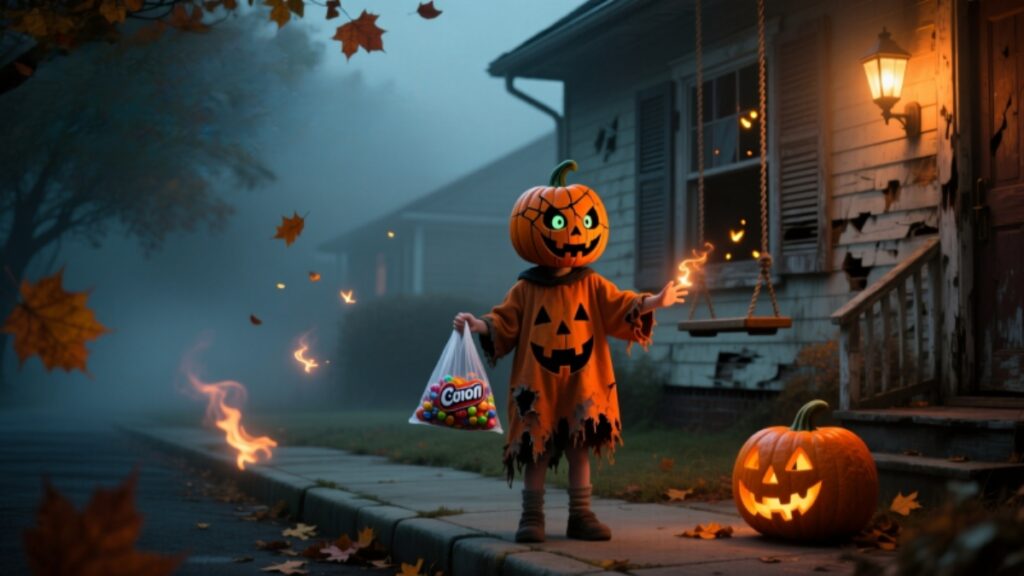
It was always the same house.
The one at the end of the street, painted gray with white trim.
Every Halloween, the door would open to a warm glow.
And behind it, Mrs. Hargrove would always be there, sitting in her creaky chair. Smiling.
The first time I knocked, I was six.
I didn’t know exactly what to say. My pillowcase was stuffed with candy requests I barely understood.
She didn’t care about the candy.
She asked my name, then about my costume, tilting her head like she could see through the mask.
“I can see who you are,” she said softly.
I felt seen. Completely.
Every year after, I went back.
Sometimes with friends.
Sometimes alone.
It didn’t matter. She remembered me. Always.
“How’s your year been, dear?” she’d ask.
By the time I was ten, our talks had grown longer.
I didn’t just ask for candy anymore.
I told her about school, the cat I wanted, the fight I had with my brother.
She listened.
And she told me stories too — little pieces of her life, regrets, joys, things that had never left her porch.
Candy became incidental.
The pillowcase, the chocolate, the lollipops — just props.
The real ritual was the conversation.
The stories we exchanged. The recognition of passing time.
By sixteen, I brought small gifts too.
A packet of pumpkin seeds. A carved ghost. A homemade lantern.
She laughed softly, her eyes twinkling.
“You always bring something,” she said. “You always remember me.”
When I turned twenty, I moved away.
College, work, life — the usual excuses.
Halloween came, and I didn’t knock.
I felt guilty.
Later, I heard she asked about me through neighbors who barely remembered my name.
“She’s always the one who brings stories,” she said.
And I wished I had been there.
Then the year I returned, I found the chair empty.
Mrs. Hargrove had died quietly, a week before Halloween.
I stood there, unsure.
I could’ve walked away.
But something pulled me to the door.
The hinge creaked like it was whispering, “It’s your turn now.”
That Halloween night, I dressed in the same costume I’d worn as a kid.
Nothing fancy. Just a simple mask.
I held a small bag of candy.
And I knocked.
A little boy appeared. Shy. Wide eyes.
He asked for candy.
I handed it to him.
Then I asked the same question she had always asked me:
“How’s your year been, dear?”
He blinked.
Then he began telling me about school, his dog, a fight with his sister.
I listened.
Just like she had listened to me all those years ago.
Each child that came afterward got the same attention.
Some asked why I was alone.
I said nothing.
The ritual didn’t need explaining.
It just needed to be done.
Over the years, I kept the tradition.
Even as children grew and moved on, new families moved in, neighbors forgot.
I still opened the door.
I still listened.
I still passed on stories.
Sometimes I noticed small changes.
The porch seemed warmer. The light brighter.
The kids hesitated less, told their stories more freely.
And sometimes, I felt her presence beside me, smiling. Approving.
The beauty of it was in the quiet continuity.
Halloween didn’t need candy to be sweet.
It was a bridge across generations.
A way to hold time gently in your hands.
One year, a girl showed up wearing a mask that reminded me of my first one.
She smiled shyly.
I realized then that the cycle was complete.
The tradition would continue, even without me.
And I knew she would carry it forward.
After the last child left, I sat in her old chair.
I held my half-empty candy bag and watched the moon rise over the quiet street.
I understood finally.
The ritual was bigger than any of us.
It wasn’t about me, or her, or even the candy.
It was about stories. Shared attention. Continuity.
Even in absence, Mrs. Hargrove lived on.
Not in pictures, not in letters.
But in the rhythm of Halloween, in the knocking, in the glow of the porch, in the listening.
As long as someone answers the door, the tradition lives.
The last trick-or-treater is never really alone.
Every story told, every secret shared, every smile given becomes part of something bigger.
A quiet legacy, gentle, tender, and timeless.
And as long as we answer, the stories go on.
Techniques to tell stories that land
These are practical moves that work across audiences.
Start with a small concrete image. Not the whole thesis. A shoe on the step. A single lantern. Leave the rest to their imagination. Their minds do most of the heavy lifting.
Use sensory detail. Not every sense every time, but a strong single sense works well. The smell of frying onions, the scrape of a chair, the taste of peppermint in the mouth when you remember Christmas. Sensory hooks create atmosphere fast.
Vary sentence rhythm. One short sentence can cut like a heartbeat. Then a longer sentence can expand the scene. It keeps listeners from napping.
Pause like a storyteller. Let silence do the spooking. A ten second gap can feel longer in a circle of listeners.
Invite participation. For communal tells, ask people to make a sound (a wind noise, a creak on the floor). That makes the story a performance and reduces the distance between teller and listener.
Use ambiguity intentionally. Not everything needs an answer. A slightly open ending keeps people thinking. It is more satisfying than a forced explanation 90 percent of the time.
Be mindful with humor. A laugh can diffuse fear and make the chilling parts sweeter. A well-placed joke is like sugar in a bitter cup.
Ethical considerations and consent
This part is important. Stories can stir strong feelings. Adults can handle more, but consent is still crucial.
Warn listeners up front if the tale touches on trauma, loss, or themes that might be triggering. A simple, “Heads up, this one touches on grief” is enough.
Avoid stories that exploit real suffering. Do not glamorize violence. You do not need gore to be scary. The implied is usually stronger.
Respect cultural sources. If you use folklore from another culture, credit it and be sensitive to context. Do not turn sacred or traumatic practices into entertainment.
Include options to opt out. Nobody should be pressured to participate.
Activities for grown-ups and mixed groups
Halloween is a chance to make ritual playful. Here are activities that work for grown-ups or mixed crowds.
Lantern exchange
Make small, hand-decorated lanterns and leave them on strangers’ porches with a note. A tiny anonymous offering that says, “You are not alone.”
Urban legend swap
Invite people to bring a local legend from their own town. Share them. Compare motifs. What repeats across places? This turns storytelling into anthropology.
Midnight reading circle
Choose a handful of short stories and read them on rotation. Keep the lights low. Serve simple hot drinks. After each story, invite one question or one remembered detail from the listeners.
Ghost story writing prompt
Give people prompts: “A city bus arrives at midnight and the driver is gone.” Let them write a 300 word piece and read it aloud. Shortform writing gets the creative juices moving.
Memory lantern
Ask participants to write down a memory they would like to release and put it in a lantern to be burned or symbolically retired. This can be solemn, so handle it with care.
Sound design workshop
Use phones and small speakers to craft a soundtrack for a short story. Layer wind, distant horns, a child’s laugh. Sound is an underrated tool for mood.
Community, ritual, and inclusion
Halloween can be a civic glue or a source of exclusion. If you are organizing in a neighborhood, think inclusively.
Offer alternatives to candy. Some families do not celebrate. Provide a “quiet trick-or-treat” time, or a table with small, non-food tokens for those who prefer it.
Make activities accessible. Use clear language, avoid sensory overload for people with sensitivities, and offer a low-stimulation room as needed.
Invite local elders to tell a story. You do not have to perform all the time. Hosting is meaningful.
Handling the darker corners
If a story brings up real grief or an anxious reaction, be present. Offer water. Offer a short grounding exercise: count five things you see, four things you can touch, three sounds you hear. You are not a therapist, but small comforts help.
If the group wants deeper conversation about mortality, memory, or trauma, consider shifting to a calmer space and inviting reflection rather than scares.
Wrap Up
If you take anything away, let it be this.
Start small. A single concrete image. A single human truth. Keep the ending open enough to linger. Be respectful of your crowd. Use humor like salt. Invite participation. Make space for those who need to opt out.
Stories are practice for living. They help us name tiny fears and then tuck them away. Even at night, even under a full moon, a story that is told well leaves us oddly comforted.
You do not need to be a master performer. You simply need to notice a small detail, say it plainly, and invite people to lean in. That is the craft. That is the warmth. That is the season.

